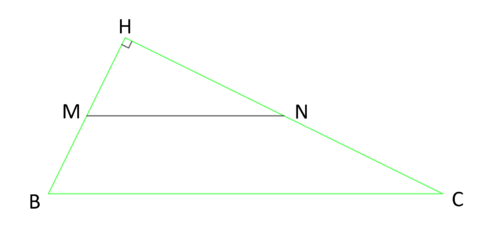Difference between revisions of "1991 OIM Problems/Problem 6"
| Line 14: | Line 14: | ||
'''Case 2:''' <math>\angle NHM \ne 90^{\circ}</math> | '''Case 2:''' <math>\angle NHM \ne 90^{\circ}</math> | ||
| + | |||
| + | [[File:1991_OIM_P6b.png|500px]] | ||
| + | |||
| + | Let the red circle in the image above be the circumcircle of triangle <math>ABC</math>. Let <math>BD</math> be a diameter of the circle. This means that <math>\angle BAD</math> and <math>\angle BCD</math> are both equal to <math>90^{\circ}</math> because right angle triangles inscribed in circles with the hypothenuse on the diameter. Therefore <math>AH</math> is parallel to <math>DC</math> and <math>CH</math> is parallel to <math>CD</math>. Thus quadrilateral <math>ADCH</math> is a parallelogram with <math>N</math> in the center and <math>HN=ND</math>. So, one can draw point <math>D</math> using <math>N</math> and <math>H</math>. Since <math>\angle MAD=90^{\circ}</math>, then <math>MD</math> is the diameter of a circle that also passes through <math>A</math>. This means that one can find point <math>A</math> from the intersection of this circle and the perpendicular to <math>MN</math> that passes through <math>A</math> and we can now start our construction as follows: | ||
| + | |||
Revision as of 18:21, 22 December 2023
Problem
Given 3 non-aligned points ![]() ,
, ![]() and
and ![]() , we know that
, we know that ![]() and
and ![]() are midpoints of two sides of a triangle and that
are midpoints of two sides of a triangle and that ![]() is the point of intersection of the heights of said triangle. Build the triangle.
is the point of intersection of the heights of said triangle. Build the triangle.
~translated into English by Tomas Diaz. ~orders@tomasdiaz.com
Solution
Case 1: ![]()
If you measure ![]() on the given points and it happens to be a right angle, then constructing the triangle is easy because point
on the given points and it happens to be a right angle, then constructing the triangle is easy because point ![]() is also point
is also point ![]() of the triangle
of the triangle ![]() . One can notice if this angle is a right angle or not if you can draw a perpendicular from point
. One can notice if this angle is a right angle or not if you can draw a perpendicular from point ![]() to line
to line ![]() and it passes through
and it passes through ![]() . If this happens to be the case, then since
. If this happens to be the case, then since ![]() and
and ![]() then one can simply draw a circle with the compass at points
then one can simply draw a circle with the compass at points ![]() and
and ![]() with radiuses measuring
with radiuses measuring ![]() and
and ![]() respectively. Then extend the lines
respectively. Then extend the lines ![]() and
and ![]() to the intersection on their respective circles at
to the intersection on their respective circles at ![]() and
and ![]() respectively. Then draw triangle
respectively. Then draw triangle ![]() .
.
Case 2: ![]()
Let the red circle in the image above be the circumcircle of triangle ![]() . Let
. Let ![]() be a diameter of the circle. This means that
be a diameter of the circle. This means that ![]() and
and ![]() are both equal to
are both equal to ![]() because right angle triangles inscribed in circles with the hypothenuse on the diameter. Therefore
because right angle triangles inscribed in circles with the hypothenuse on the diameter. Therefore ![]() is parallel to
is parallel to ![]() and
and ![]() is parallel to
is parallel to ![]() . Thus quadrilateral
. Thus quadrilateral ![]() is a parallelogram with
is a parallelogram with ![]() in the center and
in the center and ![]() . So, one can draw point
. So, one can draw point ![]() using
using ![]() and
and ![]() . Since
. Since ![]() , then
, then ![]() is the diameter of a circle that also passes through
is the diameter of a circle that also passes through ![]() . This means that one can find point
. This means that one can find point ![]() from the intersection of this circle and the perpendicular to
from the intersection of this circle and the perpendicular to ![]() that passes through
that passes through ![]() and we can now start our construction as follows:
and we can now start our construction as follows:
- Note. I actually competed at this event in Argentina when I was in High School representing Puerto Rico. I think I may have been able to build some cases of this. I don't remember much of it.
Alternate solutions are always welcome. If you have a different, elegant solution to this problem, please add it to this page.











